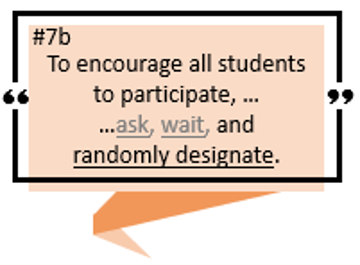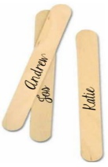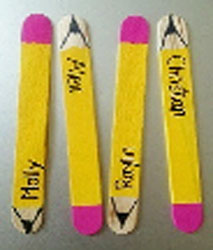30 Jan Word of Wisdom #7b: Equitable Student Participation – Part Two
To know what students do and do not yet understand, you need to distribute equitable turns among all students.
THE VALUE OF EQUITABLE TURN DISTRIBUTION
Finding out what every student in a class understands can be a lot to manage. One common formative assessment method for is a whole class question-and-answer session. Done right, it can provide you with valuable information; not done right, it can provide students a chance to zone out and/or misbehave. Formatively assessing each student’s understanding allows you to gauge the effectiveness of your instructional strategies and move on. It can also inform you of the lack thereof, and give guidance on what needs to be repeated, reviewed, and/or revisited. Last week we covered the ASK and WAIT of the ask-wait-randomly designate pattern. Now we look at two techniques to RANDOMLY DESIGNATE – to distribute turns equitably.

True Story #1 – Teachers’ Thoughts on Popsicle Sticks
In an inservice workshop I was facilitating, we had discussed the ideas that (1) telling students to raise a hand and wait to be called on limits participation to only those few students who always know the answers, and (2) allowing student call outs limits participation to the fastest and the bravest. Then someone mentioned popsicle sticks as a way to distribute turns, and one teacher loudly claimed the floor:
“Popsicle sticks! Don’t talk to me about popsicle sticks. I tried them three times, and they don’t work. I made a lovely multicolored set of sticks, each with a student’s name. I’d ask a question, randomly draw a stick from the cup, call on that student, set that stick aside to make sure I was being fair in calling on all students, and then go to the next question. I could never get through more than a few students before the class lost focus and misbehavior started.”
Several other teachers’ hands shot into the air, and when I nodded to one, she explained to the previous speaker:
“I did the same thing to distribute turns and had the same problem. But I solved it by making another set of sticks with definite up and down ends, starting with all of them up, and after calling on a student, placing that stick back in the cup upside down – and I always pull at least one down-ended stick to keep kids thinking they could be called on again. The problem is setting aside the sticks after you use them. Then those students feel safe from being called on again and feel free to do their own thing.”
The talk then turned to students who are called on and are hesitant or do not reply. One teacher shared the following:
“I let students know up front that if they want some help on a question, I’ll draw another stick. That second student can then help the first, and the first student has to repeat what the second student said (assuming the second student gave the correct answer),. That way no one gets to opt out.”
Another teacher brought smiles and laughter to the entire group when she said…
“When students tell me they don’t know, I just say, ‘Well, if you did know, what do you think the answer might be?’ And more than half the time, they think a moment and come back with a response that is right – or close to it.”
True Story #2 – Stealing an Idea from Mr. Parish
In our middle school mini-schools, four major subject area teachers formed teams that shared the same group of students. One day in my planning period, I walked by 25 of “my” students in Mr. Parish’s history class. I noticed they were paying much better attention to Mr. Parish in a social studies Q and A session than they ever did in a language arts Q & A session with me.
Each was sitting erect, making eye contact with the teacher, and listening intently. Mr. Parish stood in front of the class, holding a set of index cards in his hands. I watched as he (1) asked a review question, (2) gave students several seconds to think, and (3) then drew a card from the stack in his hand and read off a student’s name. That student responded, Mr. Parish turned the card over and made a brief note on the back, placed the card back in the stack, and repeated the procedure. What did he write on the back of the card? I have no idea. But what an effective way to distribute turns! I “stole” the idea (refer to WOW#1) and made up my own note system.
The next Q & A session, I copied Mr. Parish’s technique, and students were much more engaged. I‘ve used of equity cards and ask-wait-randomly designate to distribute turns ever since – including college classes and teacher workshops.
A TECHNIQUE TO DISTRIBUTE TURNS FAIRLY AMONG ALL STUDENTS – EQUITY CARDS
- 1. For a given class, write each student’s name at the top of an index card. Make sure all cards are face-up and right-side-up. Put a rubber band around the set. If you teach multiple classes, use a different color card for each class – or band each one with a wide rubber rand of a different color.
- Explain to students…
- You value hearing each person’s ideas and answers, and so sometimes you will use a set of cards to make sure everyone has a fair turn.
- The way it works is like this: When you use the cards,
- … everyone will hear the question,
- … everyone will have at least three seconds to think about it,
- …then you will shuffle the set of cards, randomly draw a card, and call the name on it,
- … that person gets the turn to answer,
- … and after he or she answers, that card goes back in the set to be called again.
- Use symbols to keep a record on each student’s card of his or her participation.
- Use plus, check, and minus to indicate the level of the response.
- Use a different color pen or pencil each week – or day – to keep track of how many times each student has responded.
- To keep track of who has already been called on, after marking a card, silently and surreptitiously turn that card upside down in the stack. Now when you shuffle and come to an upside-down card, you know that student has already been called on.
- Do call on at least one student twice to reinforce the belief that any student at any time could be called on. When you call on a student for the second time in a class period/day, then turn that card face-down in the set.
True Story #3 – Traveling Questions
A second-grade teacher shared the following story in a workshop follow-up session:
I used a school bus die cut to make equity cards to distribute turns. I wrote each student’s name on the front of a “bus” and then laminated them. I told my students that sometimes we were going to use the school bus cards to see who would get a turn to answer. I showed the students the set of cards and that each of their names was on a “bus.” By the second week of using them, if I forgot to pick them up whenever we started a review, the students would ask me to “use the bus cards so the questions can travel around the room.”
Until next week when we look at a way to equitably distribute opportunities to participate – may you experience success in all your academic endeavors!
Alene
Ingram, J., & Elliot, V. (2016). A critical analysis of the role of wait time in classroom interactions and the effects on student and teacher interactional behaviours, Cambridge Journal of Education, 46(1), pp. 37-53.





